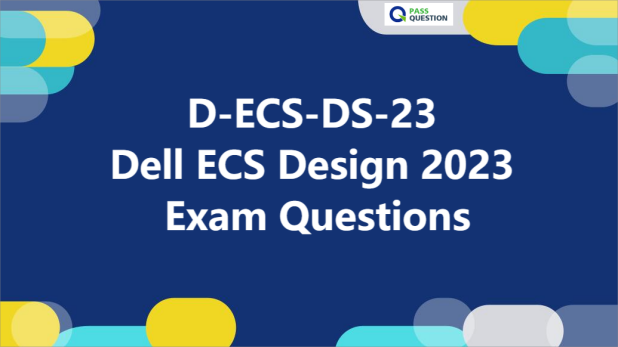
D-ECS-DS-23 Dell ECS Design 2023 Exam
Are you feeling anxious about your upcoming D-ECS-DS-23 Dell ECS Design 2023 Exam? PassQuestion offers a comprehensive set of D-ECS-DS-23 Dell ECS Design 2023 Exam Questions, meticulously designed to mirror the actual D-ECS-DS-23 exam pattern. Our D-ECS-DS-23 Dell ECS Design 2023 Exam Questions are a valuable resource for candidates to assess their current level of preparation and act as a diagnostic tool to identify areas of weakness. This allows candidates to focus their study efforts effectively and address these areas well before the exam. With our D-ECS-DS-23 Dell ECS Design 2023 Exam Questions at hand, you are equipped with the tools you need to approach the D-ECS-DS-23 Dell ECS Design 2023 Exam with confidence.

The Dell ECS Design 2023 Exam, with a 90-minute duration and 60 total questions, evaluates candidates on their understanding of architectural and design principles necessary to deliver customer solutions. It tests knowledge of ECS product's technical, hardware, and software aspects. The exam also assesses basic sizing methods and the use of relevant tools for creating real-world ECS applications. Earning this certification benefits professionals aiming to showcase their skills in designing and sizing ECS solutions, which involves strategizing and structuring ECS solutions based on business and environmental needs. To succeed in the exam, a candidate must score at least 63%.
D-ECS-DS-23 Exam Topics
ECS Solution Design Platform Architecture (20%)
● Recommend activities performed in the end-to-end process of solutions design
● Identify the node type for a given workflow or use case
● Determine the hardware requirements for a given use case or workflow
ECS Solution Design Networking (20%)
● Design an ECS networking solution to meet requirements or use cases
● Recommend the appropriate network separation deployments
● Differentiate the load balancer types and methods
ECS Solution Design Data Management (20%)
● Recommend a configuration of the ECS storage abstractions
● Differentiate between protection/replication configurations
● Design resiliency for potential failure scenarios
ECS Solution Design Cluster Access (20%)
● Identify the use cases for client protocols
● Design a multi-tenant solution using the ECS isolation features
● Identify the access control required to implement data permissions for ECS client access
● Identify the use cases for data compliance and retention
ECS Solution Design Monitoring and Performance (20%)
● Recommend the most appropriate monitoring capabilities for the situation
● Identify factors that impact performance
View Online Dell ECS Design 2023 D-ECS-DS-23 Free Questions
1. Which workflow factors must be considered when designing an ECS solution?
A. Computing, capacity, and sizing
B. Current and future workflows and capacity
C. Current and future workflows and features
D. Capacity, performance, and features
Answer: D
2. When following best practices, what must the solution architect consider when sizing an upgrade for an existing ECS cluster without adding additional nodes?
A. Only add drives of the same capacity within the node.
B. Replace all the drives with higher capacity drives.
C. Add different capacity drives within the node.
D. Disable data replication to free up storage space.
Answer: A
3. In recommending network separation deployments for an ECS environment, which strategies ensure both security and efficiency?
A. Deploying all resources in a single subnet for simplicity
B. Using private subnets for database servers and public subnets for web servers
C. Implementing network ACLs and security groups for fine-grained access control
D. Isolating development, testing, and production environments
Answer: BCD
4. What access control mechanisms are crucial for implementing data permissions in an ECS cluster for client access?
A. Role-Based Access Control (RBAC)
B. Network-based ACLs
C. Physical security of the data center
D. Identity and Access Management (IAM) policies
Answer: AD
5. Which two statements regarding namespaces on ECS are true? (Select 2)
A. Multiple namespaces can share access to the same bucket.
B. Namespaces provide logical isolation of data.
C. Namespaces provide physical isolation of data.
D. Multiple namespaces require unique bucket names.
Answer: AB
6. Which approach is recommended for managing ECS data lifecycle in a cost-effective manner?
A. Storing all data indefinitely, regardless of its value
B. Implementing automated data tiering and archival policies
C. Manual migration of data to cheaper storage classes as needed
D. Using premium storage for all data types to ensure performance
Answer: B
7. What type of information must the technology architect gather during the research process to draft a solution document?
A. Stakeholder requirements
B. Application compatibility
C. Network separation
D. User logins
Answer: A
8. Which of the following is NOT an effective method for enhancing the security of an ECS networking solution?
A. Implementing strict network ACLs and security group rules
B. Using public IP addresses for all instances to ensure accessibility
C. Encrypting data in transit using TLS/SSL
D. Segregating networks using private and public subnets
Answer: B
9. For an ECS deployment requiring frequent data recovery tests, which feature is most beneficial?
A. Snapshot and cloning capabilities
B. Long-term data archiving without retrieval options
C. Single-zone data storage for cost savings
D. Manual backup processes to external drives
Answer: A
10. For a globally distributed ECS application, which performance factor is crucial to monitor?
A. Local workstation CPU usage
B. Global Content Delivery Network (CDN) effectiveness
C. The office Internet connection speed
D. The screen resolution of end-users
Answer: B
Related Courses and Certification
Also Online IT Certification Courses & Online Technical Certificate Programs

